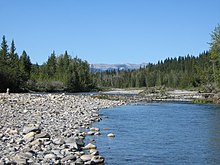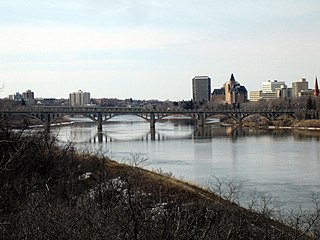
The South Saskatchewan River is a major river in the Canadian provinces of Alberta and Saskatchewan. The river begins at the confluence of the Bow and Oldman Rivers in southern Alberta and ends at the Saskatchewan River Forks in central Saskatchewan. The Saskatchewan River Forks is the confluence of the South and North Saskatchewan Rivers and is the beginning of the Saskatchewan River.

Bragg Creek is a hamlet in southern Alberta under the jurisdiction of Rocky View County in Division No. 6.
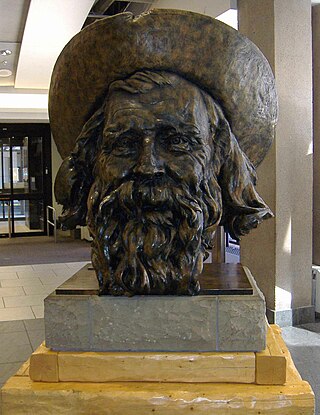
Samuel Henry Harkwood Livingston born in Ireland, he came to Canada following an unsuccessful venture in the Californian gold rush of 1849, and eventually found his way to Jumping Pound, North-West Territories, in 1873 where he opened a trading post. He was going to settle near the confluence of the Bow and Elbow Rivers in 1875 but, when the North-West Mounted Police (NWMP) arrived and established Fort Calgary, Livingston and his family moved further up the Elbow River to the current location of the Glenmore Reservoir. When the Glenmore Dam was built and the area flooded, part of the Livingston house was preserved and now stands at Heritage Park. Sam Livingston was an important man to Alberta's history. The Glenmore Reservoir gets its name from Sam too; Sam and Jane started a school on their farm that Sam named 'Glenmore School' after a place in Ireland. Glenmore is a village in County Kilkenny and quite close to his birthplace in County Wicklow.

The Bow River is a river in Alberta, Canada. It begins within the Canadian Rocky Mountains and winds through the Alberta foothills onto the prairies, where it meets the Oldman River, the two then forming the South Saskatchewan River. These waters ultimately flow through the Nelson River into Hudson Bay. The Bow River runs through the city of Calgary, taking in the Elbow River at the historic site of Fort Calgary near downtown. The Bow River pathway, developed along the river's banks, is considered a part of Calgary's self-image.

The Glenmore Reservoir is a large reservoir on the Elbow River in the southwest quadrant of Calgary, Alberta. It is controlled by the Glenmore Dam, a concrete gravity dam on the Elbow River. The Glenmore Reservoir is a primary source of drinking water to the city of Calgary. Built in 1932, with a cost of $3.8 million, the dam controls the downstream flow of the Elbow River, thus allowing the city to develop property near the river's banks with less risk of flooding.

The Oldman River is a river in southern Alberta, Canada. It flows roughly west to east from the Rocky Mountains, through the communities of Fort Macleod, Lethbridge, and on to Grassy Lake, where it joins the Bow River to form the South Saskatchewan River, which eventually drains into the Hudson Bay.

Rocky View County is a municipal district in southern Alberta, Canada that is named for its views of the nearby Rocky Mountains to the west. It surrounds most of Calgary, forming the city's northern boundary and most of the city's western and eastern boundaries. At a population of 41,028 in 2021, Rocky View County is the most populous municipal district in Alberta. Though predominantly rural in nature, Rocky View County is home to 14 hamlets, including Langdon, one of Alberta's most populous hamlets. Its rural areas are home to numerous country residential subdivisions.
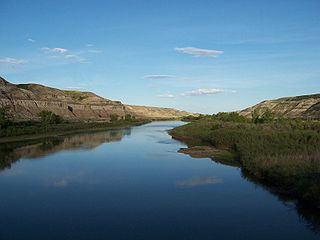
The Red Deer River is a river in Alberta and a small portion of Saskatchewan, Canada. It is a major tributary of the South Saskatchewan River and is part of the larger Saskatchewan / Nelson system that empties into Hudson Bay.
Alberta Provincial Highway No. 8, commonly referred to as Highway 8, is a highway in Southern Alberta that connects Highway 22 in Rocky View County, just north of Redwood Meadows, to Calgary.
Parkdale is a mature, inner city neighbourhood in the city of Calgary, Alberta along the north bank of the Bow River between the communities of West Hillhurst and Point McKay. It is bounded on the south by the Bow River, 28 St NW to the east, Shaganappi Trail NW to the west and on the north by 16th Avenue. Parkdale is in close proximity to both the Foothills Medical Centre and the Alberta Children's Hospital constructed in 2006, as well as the University of Calgary. Memorial Drive provides access to downtown Calgary and to Highway 1 which leads to the Rocky Mountains. Parkdale was annexed to the City of Calgary in 1910 when Calgary began to experience a "major economic and building boom." The boom ended in 1913 and further development of the Parkdale Addition as it was called, was halted because of World War I. Following World War II in the 1950s the dominant housing type that characterized Parkdale, was the bungalow. By 2014 Parkdale, like other inner city communities in Calgary, was experiencing gradual gentrification with small cottage-style bungalows being replaced by spacious flat roofed, Prairie School Frank Lloyd Wright inspired infills attracting young families with children away from the long commute suburbs to inner city ease of access to downtown, transit and work.
Elbow Valley is a rural area in the Calgary Metropolitan Region of Alberta, Canada within Rocky View County. It is adjacent to the west boundary of the City of Calgary along Highway 8. The community is bordered by Range Road 25 to the east and Range Road 31 to the west (excluding the bordering communities of Braemar Estates, Mackenas Estates, Elbow Valley West, Stonepine, Swift Creek Villas, and Lott Creek Grove). Elbow Valley is also the name used to designate a specific recreational zone southwest of the Hamlet of Bragg Creek within the Kananaskis Country park system.
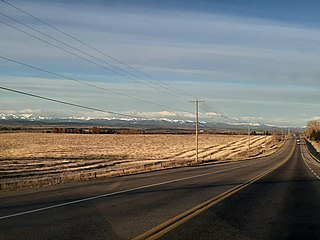
Springbank is a rural community in southern Alberta in Rocky View County. It is located immediately west of the City of Calgary, east of Highway 22, south of the Bow River and north of the rural community of Elbow Valley. Both the Trans-Canada Highway and Lower Springbank Road connect Springbank to Calgary.

The Highwood River is a tributary of the Bow River in southwestern Alberta, Canada.
Glenmore Trail is a 22-kilometre (14 mi) expressway in Calgary, Alberta, Canada, named after the reservoir which it crosses. It is a freeway between Sarcee Trail in southwest Calgary to Ogden Road in the southeast, carrying nearly 160,000 vehicles per weekday at its busiest point placing it second only to Deerfoot Trail as the busiest road in Alberta. East of Calgary, Glenmore Trail becomes Highway 560 en route to Langdon.
The history of flooding in Canada includes floods caused by snowmelt runoff or freshet flooding, storm-rainfall and "flash flooding", ice jams during ice formation and spring break-up, natural dams, coastal flooding on ocean or lake coasts from storm surges, hurricanes and tsunamis. Urban flooding can be caused by stormwater runoff, riverine flooding and structural failure when engineered flood management structures, including dams and levees, prove inadequate to manage the quantities and force of flood waters. Floods can also occur when groundwater levels rise entering buildings cracks in foundation, floors and basements. Flooding is part of the natural environmental process. Flooding along large river systems is more frequent in spring where peak flows are often governed by runoff volume due to rainfall and snowmelt, but can take place in summer with flash floods in urban systems that respond to short-duration, heavy rainfall. Flooding due to hurricanes, or downgraded severe storms, is a concern from August to October when tropical storms can affect Eastern North America. Flood events have had a significant effect on various regions of the country. Flooding is the costliest natural disaster for Canadians. Most home insurance claims in Canada deal with water damage due to sewer back-up, not fire.
Pearce Estate Park is a city park located in Calgary, Alberta. The park occupies 21 hectares along the Bow River to the east of downtown Calgary. The park contains Pearce Estate Wetland, described as "constructed wetlands filled with native plants and animals". The land was donated to the city around 1929 by then prominent Calgarian William Pearce.

In the days leading up to June 19, 2013, parts of southern and central Alberta, Canada experienced heavy rainfall that triggered catastrophic flooding described by the provincial government as the worst in Alberta's history. Areas along the Bow, Elbow, Highwood, Red Deer, Sheep, Little Bow, and South Saskatchewan rivers and their tributaries were particularly affected. A total of 32 states of local emergency were declared and 28 emergency operations centres were activated as water levels rose and numerous communities were placed under evacuation orders.

Quarry Park is a mixed-use community in Calgary, Alberta, Canada. For 50 years it was a gravel extraction site in the southeast quadrant of the city, surrounded by residential communities but used solely for industrial gravel production. In 2005, the land was purchased by a local development corporation and evolved into the community that it is today. With over 400 acres of community land, Quarry Park is now home to a market, a variety of residential developments, riverside green space and corporate office buildings including Imperial Oil and Remington Development Corporation.

Dale Hodges Park is a 40.5 hectares natural environment urban park, stormwater treatment, and public artwork installation in northwest Calgary, Alberta. It is an expansion of Bowmont Park, where stormwater from eight northwest upstream residential communities flows slowly through "water structures and landforms" inspired by "natural river morphology as well as hydrologic and sedimentation processes" that serve as filters. The park, which is connected to the regional pathway, has a boardwalk, cycling and walking trails, the Nautilus Pond, a polishing marsh, a wet meadow, man-made streams, vantage points of the Bow River, and wildlife habitat.

The Ghost River is a river in Alberta, Canada. It begins within the front ranges of the Canadian Rocky Mountains, joining the Bow River at Ghost Lake. These waters flow through Cochrane, Calgary, and ultimately into Hudson Bay. The upper reaches of the Ghost are fully protected by the Ghost River Wilderness Area.


